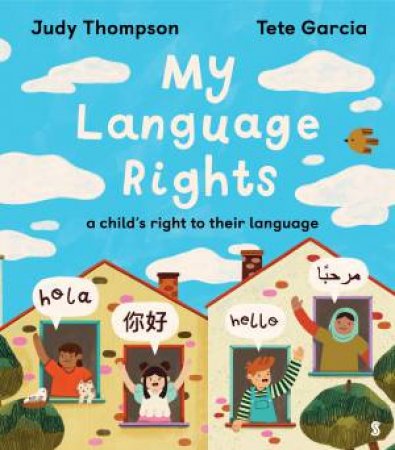My language rights: A child's right to their language by Judy Thompson and Tete Garcia

My Language Rights provides a look into the array of languages in our homes, schools, streets and cities. These different languages reflect our culture, contain our stories, keep our memories safe, and are tantamount to the passing on of a way of life from one generation to another. In Australia the diverse range of languages reflect our culture, confirming the multicultural nature of our society where 40% of people are born overseas. A walk down any street will mean listening to language other than English spoken by passers by. Languages reflect their background, their culture, their attachment to past generations, all revered through the use of the language.
Each double page has a statement about language, and the accompanying illustration reflects the truth of that statement. On one we have a group of children saying hello in different languages, and the illustration shows those children calling out their hello in their own language, with something about them also shown, which for astute readers will make them more aware of the culture that child reflects. A poignant page tells us that sometimes people stop using their own language. An arresting illustrations shows the word ‘forgotten’ and reasons for the loss of language are given. In Australian it is most upsetting to see that Indigenous languages, once numbering over 300, have now almost all been lost, partly through government regulation, but also because these people were moved from their land and so lost sight of their language within its context, and we can see this narrowing repeated across the world.
After that, positive statements are made about language: my language should be heard on television, seen in print, seen on signs, and treated with dignity. All of these lead to the most important page, of being able to share language. From this comes all the other comments about protecting language, being able to sign, sing and speak language. Every person has the right to use their own language.
The Declaration of Human Rights covers lots of rights but not language and this is the focus of this book, to highlight what this right is and how important it is for people everywhere to be able to use their own language.
PEN’s International Universal Declaration of Linguistic Rights upholds the right of every child to speak its own language, recognising language rights as a fundamental human right.
Themes: Multiculturalism, Diversity, Language.
Fran Knight